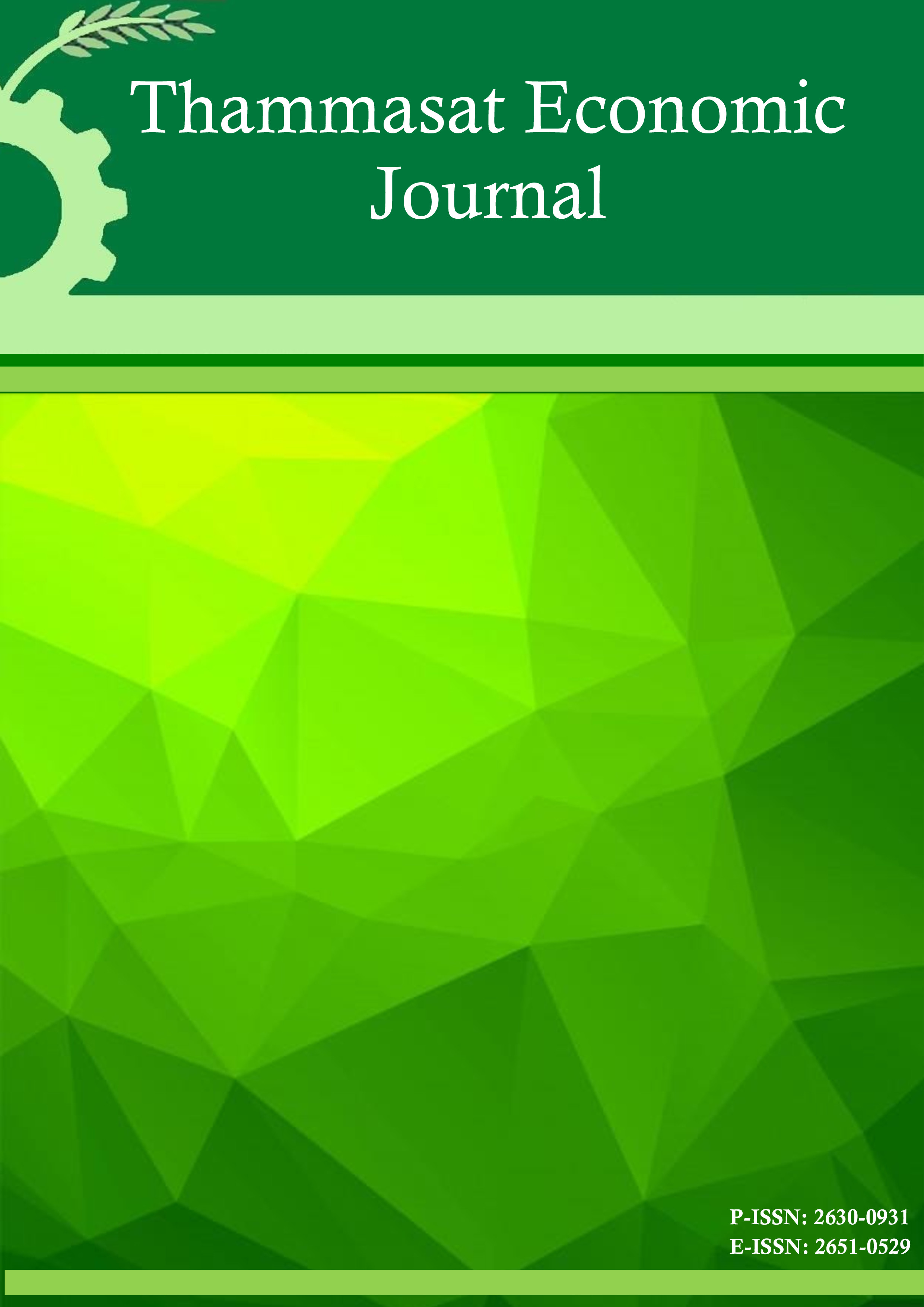Local physical capital mobility and persistency in local relative poverty
theoretical framework and a village fund case study
Keywords:
One sector growth model, Physical capital mobility, InequalityAbstract
This study develops a theoretical framework focusing on the different impact having
perfect physical capital mobility as on the long term poor, who normally have no access to
conventional capital markets, and the long term wealthy, who have human capital. Both groups of
people live together in the same sector producing the same product, but they use different modes of
production reflecting their different levels of human capital. Compared to the case of autarky, in
which there is no physical capital mobility, this analysis shows that capital mobility can impact both
the level of steady-state consumption and changes in assets. For instance, both groups of people can
either hold more assets and consume more than would be case in autarky, or they can hold the same
level of assets but consume more along the way before reaching a steady state of consumption.
Having perfect physical capital mobility can also provide a chance for the economy to achieve both
more efficiency and more equality, with a reduction in long term poverty.
In addition, a village-fund case study is provided as an example of applying of the theoretical model into a real world situation. The case study helps elaborate some impacts predicted by the theoretical framework, and helps identify some critical exogenous factors which should be useful as the extensions of the model in future.
References
2. Barro, Robert J.and Xavier Sala-i-Martin(2004). Economic growth. (second edition.) The MIT Press Cambridge, Massachusetts; London England.
3. Romer, David(2001). Advanced Macroeconomics . 2nd Edition; MacGraw Hill, Singapore
4. Azariadis, Costas and Stachurski, John (2005), “Poverty Traps,” In the Handbook of Economic Growth, edited by Phillippe Aghion and Steven N. Durlauf, Vol. 1A (El sevier), Chapter 5
5. Banerjee, A. and A. Newman (1993) “Occupational Choice and the Process of Development”, Journal of Political Economy 101(2): 274-298.
6. Banerjee, Abhijit V(2005), “The Two Poverties,” In Dercon, Stefan(2005). “Insurance against poverty”, UNU-WIDER studies of development economics; oxford university press
7. Barham, Vicky, Broadway, Robin, Maurice, Marchand ,and Pestieau, Pierre (1995), “Education and the poverty trap,” European Economic Review 39, 1257-1275.
8. Barrett, Christopher B. and Carter, Micheal R. and Ikegami, Munenobu (2008) “Poverty Traps and Social Protection,” Cornell University and University of Wisconsin-Madison, supported by the Social Protection Division of the World Bank and by the USAID Office of Poverty Reduction, SP Discussion Paper No. 0804.
9. Carter, Michael R. and Barrett, Christopher B. (2006), “The Economics of Poverty Traps and Persistence Poverty: an asset-based approach ,” Journal of Development Studies, 42:2 178-199.
10. Ceroni, Carlotta Berti (2001) “Poverty Traps and Human Capital Accumulation,” Economica (2001) 68, 203-219.
11. Galor, O. and J. Zeira (1993) “Income Distribution and Macroeconomics”, Review of Economic Studies 60(1): 35-52.
12. Jalan, Fyotsna and Ravallion, Martin(2005), “Household income dynamics in rural china,” in Dercon, Stefan(2005). “Insurance against poverty”; UNU-WIDER studies of development economics; oxford university press.
13. Jitsuchon, Somchai and Siamwala, Ammar (2007), “Tackling Poverty: Liberalism, Populism or Welfare State,” TDRI annual seminar paper, November 2007.
14. Jitsuchon, Somchai(2008) “Protecting the Poorest: Rising Food Prices and Vulnerable Groups in Thailand.” A background paper presented at UN-TU seminar, November 2008.
15. Kaboski, Joseph and Robert Townsend (2009), “The Impacts of Credit on Village Economies,”Ohio State University, This paper can be downloaded without charge from the Social Science Research Network Paper Collection at http://ssrn.com/abstract_id=1395348, Unpublished.
16. Kikuchi,T., Stachurski J. (2009), “Endogenous inequality and fluctuations in a two-country model,” J. Econ. Theory (2009), doi:10.1016/j.jet.2009.01.001.
17. Krongkeaw, Medhi (2001), “Alienated Life: Socio-Economic Characteristics of the ultra poor in Thailand,” Faculty of Economics, Thammasat University, to attend 2001 Annual Academic Seminar by TDRI on poverty reduction strategy (in Thai).
18. MacDougall, G.D.A.(1960), “The Benefits and Costs of Private Investment from Aboard: A Theoretical Approach,” Economic Record, Mar. 1960, 27, 13-35) and Solow growth model.
19. NESDB (2007a), “Poverty Assessment Report 2007,” (in Thai: รายงานการประเมินความยากจน 2550 โดยสานักพัฒนาฐานข้อมูลและตัวชี้วัดภาวะสังคม สานักงานคณะกรรมการพัฒนาการเศรษฐกิจและสังคมแห่งชาติ สิงหาคม 2551), Office of the National Economic and Social Development Board.
20. Ramsey, F. P. (1928). “A Mathematical Theory of Saving.” Economic Journal 38 (December): 543-559.
21. Ruffin, Roy J., “Growth and the Long-Run Theory of International Capital Movements,” The American Economic Review, Vol. 69, No. 5 (Dec., 1979), pp. 832-842.
22. Saardchom, Narumon(2006), “Poverty Trap: A Case Study of Thai Farmers,” project supported by Thailand Research Fund, Project Code: MRG4780140
23. Solow, Robert M. (1956), "A Contribution to the Theory of Economic Growth," Quarterly Journal of Economics 70(1): 65-94
24. Food and Fertilizer Technology Center (FFTC), “Ratoon cropping of lodged stubble,”
25. Food and Fertilizer Technology Center (FFTC) 14 Wenchow St., Taipei, Taiwan ROC, http://www.agnet.org/library/pt/2003013/
26. Tossatispattana community plan committee (2009), “Tossatispattana community plan,” Tossatispattana village, Khlong Soi 11, Moo. 2, Tambol Bueng Thonglang, Amphoe Lam Luk Ka, Pathum Thani (in Thai)
27. ปัทมาวดี โพชนุกูล ซูซูกิ และคณะ (2552), “โครงการศึกษาแนวทางการจัดทาเครื่องมือประเมินตนเองขององค์กรการเงินชุมชนฐานรากเพื่อเพิ่มขีดความสามารถในการจัดการเศรษฐกิจชุมชน,” รายงานวิจัยฉบับสมบูรณ์ ชุดโครงการวิจัยและพัฒนาระบบสวัสดิการชุมชนและองค์กรการเงินชุมชน สนับสนุนโดยสานักงานกองทุนสนับสนุนการวิจัย (สกว.)
28. หัทยา ทับสวัสดิ์ (2544), “การศึกษาผลตอบแทนการผลิตข้าวแบบล้มตอซังของเกษตรกรในพื้นที่อาเภอลาด หลุมแก้ว จังหวัดปทุมธานี,” ส่วนวิจัยครัวเรือนเกษตร การจัดการฟาร์มและปัจจัยการผลิต สานักวิจัยเศรษฐกิจการเกษตร สานักงานเศรษฐกิจการเกษตร กระทรวงเกษตรและสหกรณ์










